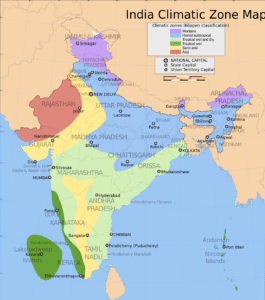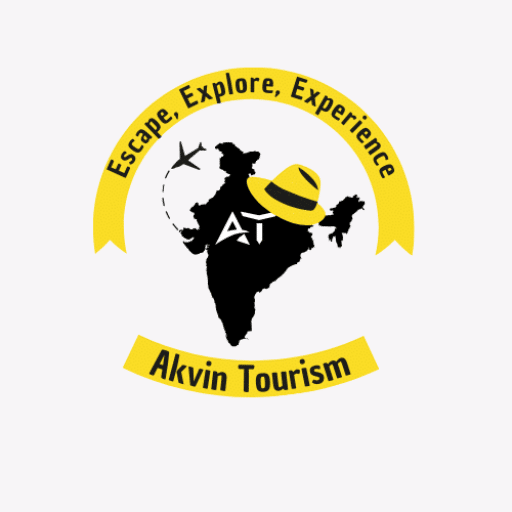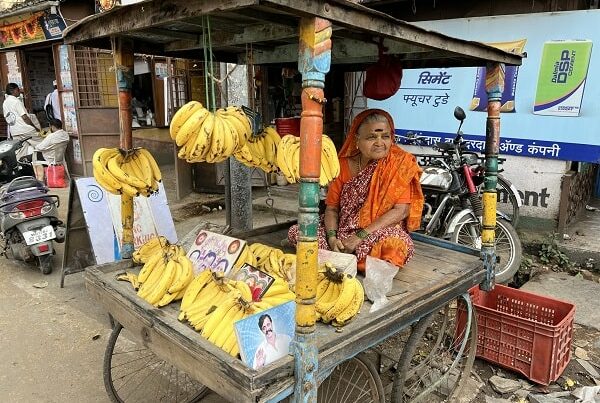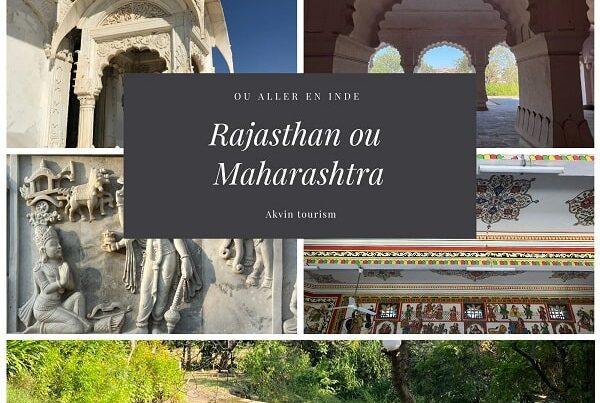Some Tour Operators or bloggers don’t hesitate to give a very peremptory answer to the question “When to go to India”, indicating a specific time of year. But the best time to travel to India is really up to you. That’s why this article, written by an India specialist, gives you some food for thought. You’ll be able to make an informed decision based on the parameters that are important to you, and which may not be the same as those of the average tourist.
Take the weather into account when deciding when to go to India.
Never forget that India is a sub-continent, part of Asia, but above all a country as big as the whole of Europe. As a result, the climate differs according to the geographical area you choose to visit in India. Fortunately, detailed statistical data are available for each state, such as the weather reports for Maharashtra and its major cities.
Several climates in a single country
As you’d expect, northern India has a temperate climate, with a latitudinal shift that corresponds to our own South. Of course, the Himalayas, on the northern border, are always cooler than the extreme altitudes. At the other end of the country, southern India, closer to the equator, enjoys a humid tropical climate. Logically, when to go to India depends first and foremost on your appetite, and even your physical resistance, to extreme heat.
This difference in climate from France influences not only when to go to India, but also what to wear in India and what to pack for a trip to India. Like all regions of the world, Indian weather changes with the seasons. In contrast, our summer, from June to September, is the monsoon season in India.

India’s three seasons
India has three distinct seasons: cool, hot, and rainy.
Relative to winter, the cool season
India’s cool season begins around October when the monsoon season ends. It ends in March. Except for the Himalayan mountains, where it’s cold all year round with snowstorms, the winter months are pleasant all over India. The easiest way to remember when to go to India is to summarize that winter in France corresponds to our local summer weather. Leaving between All Saints’ Day and Easter, you’ll find temperatures in India fluctuating between 20 and 28 degrees Celsius.
- Northern plains: temperatures often drop sharply.
- Southern India: cool days, but never really cold
- In the east, showers and snow are frequent.
Summer from hell, the hot season
Summer is short in India. Temperatures gradually warm up until mid-April but remain bearable. Then, in the central regions, the thermometer rises above 40C, with regular peaks of 45 or 50C. It’s too hot to move during the day and sleep at night.
These extremes are most prevalent in areas where travel agencies cater to the tourist crowds: Delhi, Agra, and Rajasthan, hence their recommendations are not to travel to India during the hot season. A certain mercantile logic. Nevertheless, the regions close to the Indian Ocean, even to the south, benefit from very pleasant cool breezes in the morning. If you’re an early riser, you’ll be able to organize your schedule around early-morning excursions, afternoon indoor visits, and evening beach time, when there’s no longer any danger of sunstroke.
Of course, the coolness of the peaks becomes an asset in summer: the ideal time to visit the Himalayas. The same goes for the cities on the banks of the Ganges. If this is your destination, you’ll know when to go to India, without following other tourists.
The monsoon wet season
A little later, in June, comes the monsoon, the rainy season. As much as the abundant rainfall displeases tourists, it is essential to the crops and plantations that feed millions of Indians. The atmosphere becomes electric and difficult to bear. Until September, heat, humidity, and low-pressure systems produce short, violent thunderstorms, veritable hurricanes. Monsoon rains then progress diagonally across the continent from southwest to northeast. This means that the monsoon period varies from region to region.
So if you want to avoid the monsoon, just choose the region according to its seasonal advance, without worrying about when to go to India.
Is monsoon the right time to visit India?
Every year, the media never tires of broadcasting impressive images of the torrential rains that fall on India during the monsoon season. It’s true that at this time of year, water plus heat cause major damage throughout the country. Floods and landslides change the landscape and represent a significant hazard. As does the risk of avalanches for skiers and hikers in the Alps and Pyrenees. Does this mean that nobody enjoys the snow in France? No.
So if you want to experience India as Indians know it, don’t put any seasonal brakes on your travels. The monsoon is an integral part of Indian culture and guarantees a complete change of scenery. My only advice is not to devote your first stay in India to it. The rainy season means inconveniences for travelers whose means of transport are likely to be delayed – even more so than usual. As for the advantages, you’ll discover them later in your reading. For a gentle first discovery of India, opt for a more classic tour of a city of wonders.
The special case of Maharashtra
Maharashtra is a state that only receives rainfall during the rainy season. This influx of water completely transforms the landscape. With the help of the many peaks, traveling during the monsoon season in Maharashtra is guaranteed to see many waterfalls. It’s a favorite time of year for trekking in the region’s many mountains.
When deciding when to go to India, monsoon season can be a good time, especially in Maharashtra.
Some sites are completely different. If you visit Raigad Fort during the monsoon, you’ll have your head in the clouds. It’s one of the many magical places to visit during the rainy season.
In the video below, you have a good example of the experience that awaits you during the monsoon season in Maharashtra.
When to go to India to avoid the crowds?
It goes without saying that, if everyone follows the weather to find out when to go to India, everyone leaves at the same time. It’s unstoppable. Just take a look at the famous N7 in the Ile de France – Côte d’Azur direction at the start of summer, and in the opposite direction at the start of the new school year. The same applies to major international tourist flows. At these key times, booking times for transport and accommodation become longer. What’s more, the journey itself takes on the appearance of a transhumance. December and January are the months when tourist numbers are at their highest. Of course, for your vacation, you don’t have to endure the madness of Indian cities. Choose balanced itineraries that alternate intensity and respite. For example, between two chaotic urban centers, take a walk in a nature park or enjoy the seaside.
Avoid mass tourism in India
In fact, if you don’t like crowds, noise and long queues, India is a challenge for you at any time of year. There’s no need to add to your enjoyment by rushing through the crowds. So the real solution is not to leave for India on a specific date, but rather to select your destination according to the number of tourists. For example, go to Maharashtra rather than Rajasthan. It’s like going on vacation to Normandy or Brittany: less hot and less crowded, but also more authentic than the Mediterranean coast.
India welcomes the most visitors in December, and the fewest in May and June. Let’s be clear: most of them cluster around a few ultra-mediatized spots, such as the Taj Mahal. So all you need to do is take a step back, in the truest sense of the word, to discover India off the beaten track, without neglecting the must-see tourist sites and world heritage sites.
Public holidays in India
It goes without saying that you, the Western tourist, are not the only one to travel in India. Indians themselves take advantage of their own vacations to travel and visit their country. So it’s interesting to know where Indians go on vacation. And which areas are emptied during this period? To illustrate: Have you ever thought how the Japanese and Vosgians must find Paris quiet in summer?
In fact, the mass effect is less intense in India than in Europe, because labor laws vary from one Indian state to another – and there are 28 of them, not counting the Unio territories! What’s more, companies are free to apply the main social principles.
Similarly, public holidays, which mean that schools, banks and other administrations are closed, offer great flexibility in a society accustomed to diversity. Some public holidays are national, while others are exclusive to certain states, or are subject to a specific religious belief. In fact, every year Indian newspapers publish the official list of Indian public holidays, which you can consult when you travel to India.
This calendar of public holidays in India is closely followed by professional tour guides, all the more so when they live in the country as we do.
Discover India’s major traditional holidays, when to go?
Can you imagine a foreign visitor coming to Paris on July 12 and then missing the July 14 parade, fireworks and ball? It would be a real shame!
You too can take advantage of your stay in India to attend one of the major religious or cultural festivals that punctuate the year. Here again, remember that some events are national (like May 8th in our country) and others are only regional (like the Fête de la bière or the Festival d’Avignon). What’s more, some of them are based on the lunar calendar, so their dates are not fixed (Team Easter!). As a result, the experience that appeals to you determines when to go to India.
Public holidays in India
The Indian government and the various states that make up this country demonstrate a great capacity for adaptation that is hard to imagine for French people used to centralization and uniformity. This is demonstrated by the flexible organization of public holidays. The system is more flexible than simple.
Only three dates are listed as national holidays and are observed throughout India.
- January 26: Republic Day, entry into force of the Indian constitution since 1948
- August 15: Independence Day, end of British colony in India in 1947
- October 02: Gandhi Jayanti, Mahatma Gandhi’s birthday
Every year, the national government announces a list of official public holidays
- Gazetted holidays: national closure of banks, public schools and public bodies. Private companies can choose whether or not to close at their own convenience, although a minimum number of public holidays must be granted to their staff.
- Restricted holidays are days granted by private companies to their employees to respect India’s cultural and religious diversity. Banks, public schools and government agencies remain open.
In each state, local public holidays complete the national list. Taken together, these often provide convenient long weekends for tourism.
Public holidays in most states
- April 4: Mahavir Jayanti, the most important festival of the Jain religion
- April 14: Dr Babasaheb Ambedkar Jayanti, birthday of the father of the Indian constitution
- November 14: Diwali, Bali Pratipada, 4th day of the festival of lights
- November 27: Guru Nanak Jayanti, Sikh founder
Maharashtra-specific festivals
- February 19: Chhatrapati Shivaji Maharaj Jayanti, birthday of the famous chef, icon of Maharashtra
- March 22: Gudhi Padwa, New Year’s Day
- May 1: Maharashtra Din, commemoration of the formation of the state of Maharashtra
- August 16: Parsi new year
- September 19: Ganesh Chaturthi, Hindu deity who protects Maharashtra
Every religion has its festivals
India is a fine example of religious tolerance, where everyone is free to follow their own beliefs, thanks to public holidays around the major events of all religions.
Hindus
- February 18: Mahashivrati, dedicated to Shiva
- March 7: Holi, 2nd day of the festival of colors (link to tour which includes this festival)
- March 30: Ram Navami, birth of King Rama, reincarnation of the God Vishnu
- October 24: Vijaya Dashami or Dussehra, victory of good over evil
Buddhist
- May 5: Buddha Purnima, birth of Gautama Buddha
- November 12: Diwali amavasaya, Laxmi puja, new moon day of the festival of lights
Christians
It can be folkloric to observe for yourself the differences and similarities of practices around a festival you know by heart, whatever your beliefs. As a family or among pilgrims, take up the challenge and decide when to go to India, against the grain of European Judeo-Christian crowds.
- April: Easter Friday
- December 25: Christmas
Muslims
- Depending on the year: Ramadan (Id ul Fitr), end of Ramadan
- June 28: Bakrid, festival of sacrifice
- July 29: Muharram, first month of the calendar
- September 28: Eid-E-Milad, birth of the Prophet Muhammad
Seasonality of your favorite activities in India
Travel is often about transposing your interests to another place. History buffs want to discover a country through this prism, while sports fanatics dream of practicing their sport under new horizons. This activity criterion comes into play when choosing when to go to India.
Visiting museums and sacred temples
Historical and religious monuments are popular with foreign and local tourists alike. Indians make up the majority of daily visitors to the Taj Mahal.
Here, there’s no choice but to follow the calendar of public holidays, depending on whether you want to share a moment of collective fervour or visit in relative peace and quiet.
Which sport and when should you visit India?
As well as practising your usual sport, your stay in India will give you the opportunity to discover popular sports in India. However, depending on the sporting experience you’re looking for, the choice of when to go to India is once again variable. Rafting the Ganges or trekking are more seasonal than yoga in an ashram. The same is true of cricket, an emblematic sport inherited from English colonization, and dependent on the condition of the lawns and rainfall. On the other hand, whatever the season, you can try your hand at the many styles of Indian dance, or admire the fascinating spectacle.
Wildlife watching
India is home to some fascinating wildlife for those of us accustomed to admiring these exotic animals only in circuses or zoos. That’s why it’s so attractive to observe them in their natural environment. Optimum conditions follow the rhythm of these beasts: hunting, reproduction, migration etc… Just as there’s a season for listening to deer bellow in European forests, there’s a season for observing ibis, tigers…
For a unique wildlife photo safari experience, you won’t have a choice of when to go to India. In this context, you’ll need to block your dates of stay according to the life of the animals.
- December to February: birds and antelopes in Rajasthan.
- January to May: Indian lion in the Gir forest.
- February and March: Asian one-horned rhinos in Kaziranga.
- March and April: tigers, leopards and wild elephants in Corbett Park.
- April and May: wild bison in southern Kerala.
- August and September: waterfowl in Keolada Ghana.
The decisive budget for when to go to India
Everyone knows that the price of tourist services fluctuates according to the principle of supply and demand. Leisure and travel professionals modulate the flow of travellers and manage to balance their load factors over a wider daily range.
The average price of a single ticket to India is around 550 euros, depending on the destination. What’s more, India’s peak tourist season coincides with the European school vacations, Christmas and the end of the year. An ideal situation for tour operators and transport companies, who raise prices to the maximum. So, to save a few rupees, book your tickets at least 5 months in advance.
If possible, be flexible when you travel to India. You’ll save a lot of money. For example, in mid- or low-season, one or two months’ booking is enough and your whole vacation will cost half as much.
Another tip for further savings on transport costs: travel during the week rather than at weekends, when booking requests are more frequent, as we naturally follow the rhythm of full weeks.
Transport to India
For its speed and ease, air travel has become the most obvious means of getting to India from the rest of the world, especially Europe. Airlines are the champions of fluctuating fares depending on the day and time of day. If you travel in the off-peak season, i.e. during the monsoon season, your plane seats will cost you 30% less than during the peak tourist season for India. This argument may convince you of the benefits of rain for a vacation out of the ordinary. Low cost is an option for those looking for a bargain, provided you check the general conditions of sale to avoid unpleasant surprises in the form of surcharges and other unforeseen costs.
It goes without saying that other means of transport, such as boat, train or car, also offer advantages, such as taking the time to fully enjoy the journey and the regions crossed on this occasion, as well as meeting the locals. Nonetheless, they do require a great deal of forethought in terms of travel time and formalities. So, in the question “When to go to India?”, the key word not to be overlooked is “Go”!
Accommodation in India
When tourists flee the country because of rainy weather, hotels and other accommodation options compete with each other mercilessly. That’s why, over and above the quality of the welcome, nightly rates for the same establishment drop during the monsoon season. It’s up to you to find a compromise between budget and enjoyment, so you can decide when to go to India and make the most of your vacation.
India in the rain
Since rain scares tourists, promotional discounts are a great way to keep them coming back. Up to 50% off accommodation. Enough to convince you to admire the green countryside and breathtaking light between two torrential downpours. This exceptional experience will leave you with unforgettable memories. And breathtaking photos. You’ll be able to say “I was there!
In short, when is the best time to go to India for a dream trip?
The best answer is within you! Here’s a simple way to make your decision:
- Take a promotional calendar with the whole year on one page.
- Cross out all the dates when it’s impossible for you to get away from home, whatever the reason: job, family holiday, children’s schooling, etc…
- Put in color the dates of the events that attract you most to discover India and its culture.
- Cross out the periods of the year when India is not an option for you, according to the four key parameters:
- Weather
- Traffic
- Activities
- Budget
- Visibly frame the weeks or months which are not crossed out and which are fully or partially colored.
Now you know when to go to India, in a way that’s ideal for you!
Now it’s easy to organize your trip to suit your personal tastes and requirements.
The Akvin team is here to help you plan your stay in Maharashtra




